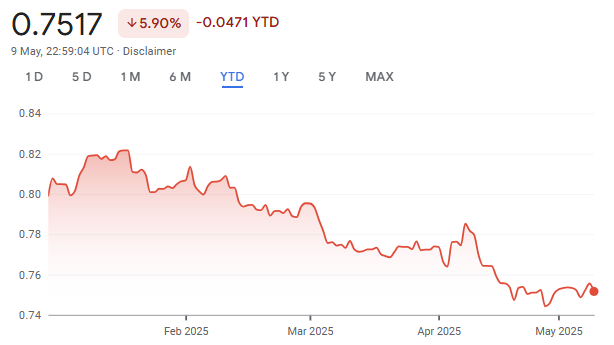One month after US president Donald Trump jolted markets with his controversial 'Liberation Day' tariffs, most of the initial panic has subsided. Talks have resumed and relations are tentatively improving, even with long-time adversary China. Investors appear to be slowly regaining confidence, though a sobering consensus is emerging: the dollar is on a steady path of decline.
This is the view of Iain Stealey, global fixed income chief investment officer at JPMorgan Asset Management and co-manager of the JPM Global Bond Opportunities fund, who declared: “We have reached peak dollar and peak US enthusiasm”.
“The dollar has been on a one-way trade for the past couple of decades, and that is now being unwound,” he said. “I'm not sure whether it will continue to unwind at the same pace that we have seen over the past month or so, but I do think a structural decline of the dollar has begun.”
Over the year to date, the currency has lost 5.9% of its value against the pound, as the chart below shows, despite regaining some of its losses yesterday.
US dollar in sterling terms over the year to date
Source: Google Finance
The main culprit is politics, Stealey said, but he also pointed to market dynamics in Asia, where support for the dollar has started to wane.
In Asia, people generally prefer to save money in unhedged dollar assets. This worked while the dollar was appreciating, but to avoid volatility, investors now need to adjust their hedge ratios – something insurance companies across Taiwan, Japan and Korea have already begun doing, Stealey explained.
Asian and emerging markets stand to gain significantly from a weaker dollar, the manager continued. “If traditional support for the dollar from Asian holders continues to fade, a weaker dollar – and the resulting decline in real yields – could provide a powerful tailwind for emerging market debt,” he said.
Emerging markets aren’t only benefiting from a positive currency impact, but also from constructive monetary policy.
“Central banks in emerging markets jacked up rates more aggressively and more swiftly than in developed markets, but they haven't cut them as much over the last year or so,” Stealey explained.
This has brought “quite attractively high real yields on offer” in places such as Mexico, where bond yields are over 9% while inflation is running at 4-5%, and Brazil. The £178m JPM Global Bond Opportunities fund has 5.4% in Mexico and 11.1% in emerging market debt.
Stealey isn’t the only manager finding emerging market debt appealing. Mike Riddell, manager of the Fidelity Strategic Bond fund, increased his allocation to local-currency emerging market debt to 16%– the highest level of his career.
For investors, the implications of a structurally weaker dollar are far-reaching, and for some, a prompt to reconsider portfolio positioning. The shift and the subsequent uncertainty have fuelled a surge in demand for traditional safe havens like gold, but at the same time, other so-called safe assets – most notably US treasuries – are facing a more critical reassessment. April’s disappointing performance across US fixed income has led some to question whether treasuries still deserve their reputation as a reliable refuge in times of market stress.
Despite these concerns, Stealey continues to view US government bonds as a cornerstone of stability, maintaining a significant 45.1% exposure in his fund. He argued that treasuries may retain their safe-haven status for some time yet, particularly if president Trump continues to retreat from his aggressive ‘Liberation Day’ stance.
“If nothing changed from the Liberation Day plan, the US would head into a recession,” Stealey said. “But Liberation Day was peak tariff uncertainty, and we are walking back from it slowly but surely.”





